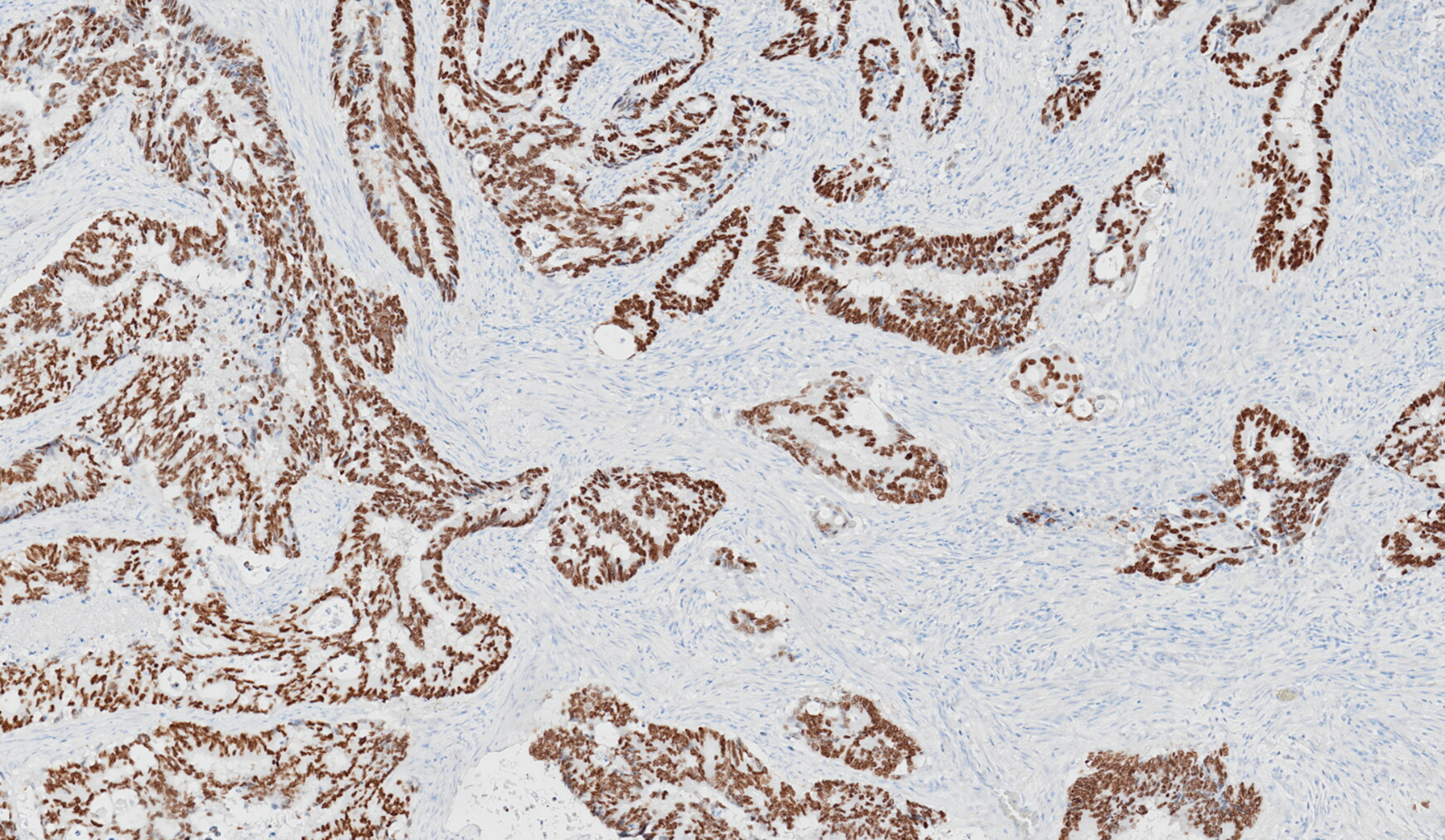Special AT-rich sequence-binding protein 2 (SATB2) is a nuclear transcription factor strongly expressed in the epithelium of the lower gastrointestinal tract, including colon, appendix and rectum. Expression is also seen in neuronal cells of the cerebrum, epithelial cells of renal convoluted tubules, germ cells of the testis (mainly spermatocytes) and a subset of lymphocytes. SATB2 has also been reported as a biomarker of osteoblastic differentiation in bone and soft tissue tumours. It is typically absent in most other normal tissues such as liver, pancreas, salivary gland, breast, thyroid, pituitary, adrenal, parathyroid and prostate.
Intended use
SATB2 is a valuable diagnostic tool, particularly in cases where the primary site of the tumour is unknown (referred to as Cancer of Unknown Primary, or CUP). In such cases, SATB2 can help indicate whether the tumour originated in the lower gastrointestinal tract. Studies show that combining SATB2 with CDX2, (another nuclear transcription factor important in intestinal development), significantly enhances the identification of colorectal carcinomas. SATB2 expressed in 79-95% of cases.
SATB2 positivity is also observed in most neuroendocrine neoplasms of appendiceal and rectal origin. Its selective expression pattern supports diagnostic accuracy and makes SATB2 a strong complement to other gastrointestinal markers in differential diagnosis.
References:
Magnusson K, de Wit M, Brennan DJ, Johnson LB, McGee SF, Lundberg E, Naicker K, Klinger R, Kampf C, Asplund A, Wester K, Gry M, Bjartell A, Gallagher WM, Rexhepaj E, Kilpinen S, Kallioniemi OP, Belt E, Goos J, Meijer G, Birgisson H, Glimelius B, Borrebaeck CA, Navani S, Uhlén M, O'Connor DP, Jirström K, Pontén F. SATB2 in combination with cytokeratin 20 identifies over 95% of all colorectal carcinomas. Am J Surg Pathol. 2011; 35(7): 937-48. https://doi.org/10.1097/PAS.0b013e31821c3dae
Bellizzi AM. SATB2 in neuroendocrine neoplasms: strong expression is restricted to well-differentiated tumours of lower gastrointestinal tract origin and is most frequent in Merkel cell carcinoma among poorly differentiated carcinomas. Histopathology. 2020; 76(2): 251-264. https://doi.org/10.1111/his.13943.
Dragomir A, de Wit M, Johansson C, Uhlen M, Pontén F. The role of SATB2 as a diagnostic marker for tumors of colorectal origin: Results of a pathology-based clinical prospective study. Am J Clin Pathol. 2014; 141(5): 630-8. https://doi.org/10.1309/ajcpww2urz9jkqju.
Li Z, Roth R, Rock JB, Lehman A, Marsh WL, Suarez A, Frankel WL. Dual Immunostain With SATB2 and CK20 Differentiates 5 Appendiceal Mucinous Neoplasms From Ovarian Mucinous Neoplasms. Am J Clin Pathol. 2017; 147(5): 484-491. https://doi.org/10.1093/ajcp/aqx023.
Lin F, Shi J, Zhu S, Chen Z, Li A, Chen T, Wang HL, Liu H. Cadherin-17 and SATB2 are sensitive and specific immunomarkers for medullary carcinoma of the large intestine. Arch Pathol Lab Med. 2014; 138(8): 1015-26. https://doi.org/10.5858/arpa.2013-0452-OA.
Schmitt M, Silva M, Konukiewitz B, Lang C, Steiger K, Halfter K, Engel J, Jank P, Pfarr N, Wilhelm D, Foersch S, Denkert C, Tschurtschenthaler M, Weichert W, Jesinghaus M. Loss of SATB2 Occurs More Frequently Than CDX2 Loss in Colorectal Carcinoma and Identifies Particularly Aggressive Cancers in High-Risk Subgroups. Cancers (Basel). 2021; 13(24). https://doi.org/10.3390/cancers13246177.
EMSCA0002EN
